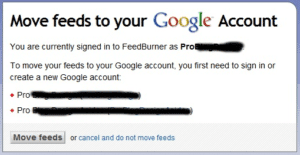 If you use FeedBurner, the clock is ticking. Google has announced that FeedBurner is deprecated (going the way of the dodo) on October 20. That gives you only ten days to figure out if you need to do anything, and if so, what you’re going to do.
If you use FeedBurner, the clock is ticking. Google has announced that FeedBurner is deprecated (going the way of the dodo) on October 20. That gives you only ten days to figure out if you need to do anything, and if so, what you’re going to do.
What is FeedBurner?
To put it in simple terms, Feedburner is a feed “enhancer”. It takes your default news feed (basically a feed of all your blog posts), and adds more functionality to it without you having to modify it yourself. If you’ve already had your blog up for some time, chances are that many of your readers have already subscribed to your default RSS feed.
FeedBurner is very common for WordPress blogs, and we use it at our agency to produce the “Related Posts” feature found at the bottom of many of our blog posts.
If you don’t know if you use FeedBurner or not, ask your webmaster or web designer TODAY. Time is short for making the necessary changes.

You might be using Google FeedBurner now
If you’re already using Google Feedburner, don’t worry about this. Go back to bed, or write another blog post. How do you know of you’re using Google FeedBurner or not?
 Log into your FeedBurner account and look at the navigation banner at the top. If you see the Google FeedBurner logo, you’ve already migrated from the old system, so stop reading here.
Log into your FeedBurner account and look at the navigation banner at the top. If you see the Google FeedBurner logo, you’ve already migrated from the old system, so stop reading here.
Making the change
If you haven’t yet made the change to Google FeedBurner, do the following:
- Sign in to FeedBurner and click the “Move Your Account Now” link.
- Choose the Google account you wish to use, or create a new one.
 Enter any extra details as requested. All your feeds should be listed on the next page.
Enter any extra details as requested. All your feeds should be listed on the next page.- Click “Move Feeds” to start the transfer. When you see the “Success!” message, all your feeds have been transferred successfully.
- If you use a WordPress plugin to redirect your feed, make sure you update it to the new address, http://feedburner.google.com/fb/a/FeedName.
- Check all the links to the feed on your site. If any of them are hard-coded into the website, you’ll need to have your web team change them, too. Also, remember that the code for email subscriptions will change as well.





